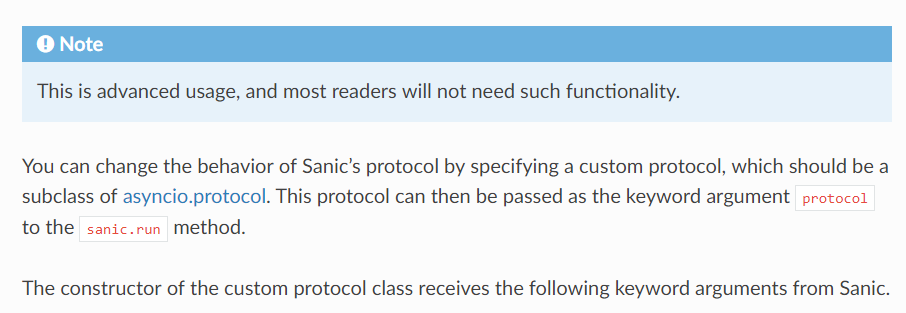1,Custom Protocol:自定义协议

温馨提示:自定义协议是一个高级用法,大多数的读者不需要用到此功能
通过特殊的自定义协议,你可以改变sanic的协议,自定义协议需要继承子类asyncio.protocol,这个子类在sanic.run方法中传输关键字protocol协议
自定义协议的构造类从sanic中接收关键字参数.
loop: anasyncio-compatible event loop.(循环:异步兼容事件循环)connections: asetto store protocol objects. When Sanic receivesSIGINTorSIGTERM, it executesprotocol.close_if_idlefor all protocol objects stored in this set.(连接:一个存储协议对象的集合当接收到一个信号的时候,将会执行自定义的协议,close_if_idle会为所有的协议对象存储在这个集合中)signal: asanic.server.Signalobject with thestoppedattribute. When Sanic receivesSIGINTorSIGTERM,signal.stoppedis assignedTrue(信号:一个sanic服务器信号对象是用sanic停止的属性来控制的,当sanic接收到信号,stopped的属性就会变成Ture)request_handler: a coroutine that takes asanic.request.Requestobject and aresponsecallback as arguments(处理请求:将sanic的请求对象和响应回调作为参数的协程)error_handler: asanic.exceptions.Handlerwhich is called when exceptions are raised.(错误处理程序:当异常被抛出的时候,调用sanic.exception.Handler)request_timeout: the number of seconds before a request times out(请求超时:在请求超时前会有一些秒数.)request_max_size: an integer specifying the maximum size of a request, in bytes.(最大请求的量:指定请求最大的整数,以字节为单位)
例子:

如果一个处理函数没有返回一个HTTPResponse对象,表名一个错误的发生在默认的谢一中.通过重写write
_response协议方法,如果处理程序返回一个字符串被转换成一个HTTPResponse响应对象
from sanic import Sanic
from sanic.server import HttpProtocol # 在sanic的服务中存在HTTP协议
from sanic.response import text
# 实例化一个Sanic对象
app = Sanic(__name__)
class CustomHttpProtocol(HttpProtocol):
# 初始化方法
def __init__(
self,
*,
loop,
request_handdler,
error_handler,
signal,
connections,
request_timeout,
request_max_size,
):
# 执行父类的初始化方法
super().__init__(
loop=loop,
request_handler=request_handdler,
error_handler=error_handler,
signal=signal,
connections=connections,
request_timeout=request_timeout,
request_max_size=request_max_size
)
# 返回响应的方法
def write_response(self, response):
# 如果存在response对象
if isinstance(response, str):
# 封装response响应对象
response = text(response)
self.transport.write(
# 封装请求的信息
response.output(self.request.version)
)
self.transport.close()
@app.route("/")
async def string(request):
return "string"
@app.route("/i")
async def response(request):
return text("response")
app.run(host="0.0.0.0", port=8000, protocol=CustomHttpProtocol) # 启动服务的时候指定协议为自定义协议
2,Socket(网络套接字)

Sanic可以使用Python中的socket模块来容纳IPV4的socket
from sanic import Sanic
from sanic.response import json
import socket
# 实例化socket对象
sock = socket.socket(socket.AF_INET6, socket.SOCK_STREAM)
sock.bind(("::", 7777)) # 绑定一个元组
# 实例化一个sanic对象
app = Sanic()
# 业务处理函数
@app.route("/")
async def test(request):
return json({"hello": "world"})
if __name__ == '__main__':
app.run(sock=sock) # 以网络套接字的形式开启服务
UNIX的例子如下:
import signal
import sys
import socket
import os
from sanic import Sanic
from sanic.response import json
server_socket = "/tmp/sanic.sock"
# 实例化socket对象
sock = socket.socket(socket.AF_UNIX, socket.SOCK_STREAM) # socket.UNIX这个参数不对,是不是官网错了
sock.bind(server_socket) # 绑定
# 实例化Sanic对象
app = Sanic()
@app.route("/")
async def test(request):
return json({"hello": "world"})
def signal_handler(sig, frame):
print("Exiting")
os.unlink(server_socket)
sys.exit(0)
if __name__ == '__main__':
app.run(sock=sock)